GREEN LIVING

FASHION ISSUE
The Future of Fashion
Avant-Garde in Arizona?
Breaking Down Remake's 2024 Fashion Accountability Report
Testing the Outer Limits
Kelly Slater redefines the boundaries of sustainability with clothing brand Outerknown




Avant-Garde in Arizona?
Breaking Down Remake's 2024 Fashion Accountability Report
Kelly Slater redefines the boundaries of sustainability with clothing brand Outerknown


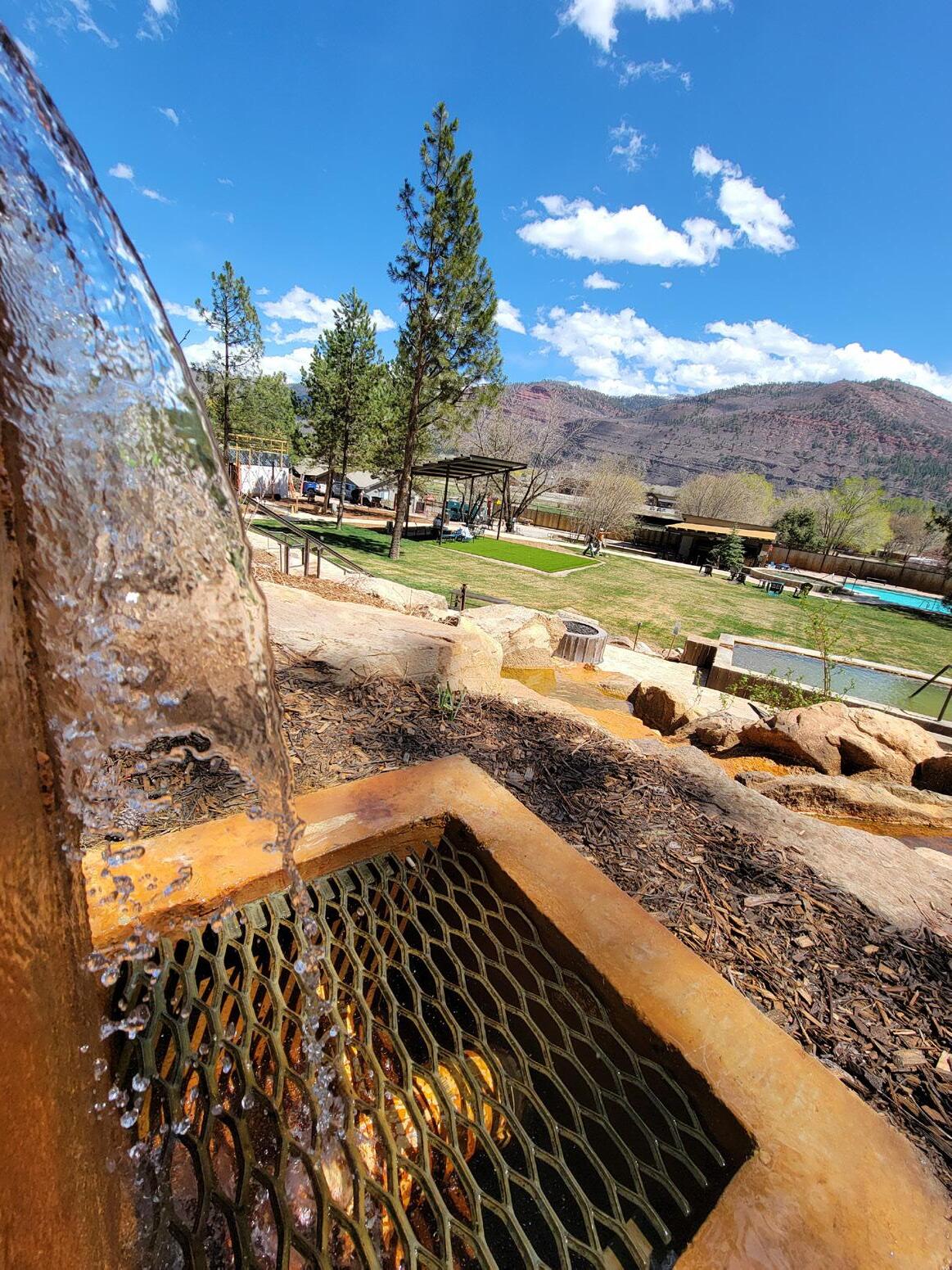

Utilizing natural elements to balance water.


Natural hot springs have long been revered as some of the most powerful healing environments on Earth. For centuries, civilizations have turned to these mysterious waters, rich in minerals, to treat a wide range of ailments. Legendary tales, like that of the Fountain of Youth, speak of springs that could restore vitality and heal the body. While these stories may seem mythical, the real benefits of hot springs are undeniable, even if not fully understood.
Hot springs are abundant in essential minerals such as calcium, iron, potassium, magnesium, zinc, silica, lithium, and sodium, among others. Soaking in these mineral-rich waters allows the skin, the body's largest organ, to absorb these vital nutrients, potentially alleviating mineral deficiencies that are common due to poor diets and lifestyles today. This natural mineral infusion, combined with the warmth of the water, enhances circulation, delivering oxygen and nutrients more efficiently throughout the body.
The therapeutic effects of warm water have been recognized in modern medicine, where treatments like balneology — using bathing to treat disease — are employed to aid recovery from injuries, cardiac issues, and other health challenges. The soothing properties of warm water are also known to reduce stress and promote better sleep.
BY MICHAEL GEYER
New studies show how highly oxygenated water can contribute significantly to the oxygen supply of the human dermis and epidermis. At Exceptional Water Systems, we’ve taken the healing power of hot springs to the next level by integrating our cutting-edge Ultra-Fine Bubble technology. Our Aqua Fuzion generator infuses the water with ultra-fine oxygen bubbles, significantly increasing the oxygen content and amplifying the therapeutic effects of the natural minerals. Visitors to hot springs equipped with this technology have reported even greater benefits, from improved relaxation to enhanced well-being.
At Exceptional Water Systems, we don’t just treat water-we transform it. Whether it’s a swimming pool, spa, hot tub, or cold plunge, we elevate every water sanctuary into a haven of health and rejuvenation. Our commitment goes beyond providing the ultimate experience for those who immerse themselves; we ensure that every drop, even as it returns to earth, leaves a positive impact. Exceptional Water Systems is dedicated to delivering the purest, most revitalizing experiences, enhancing the well-being of both people and the environment.
Discover how we can enhance your hot spring experience by contacting us at www.exwsystems.com or (480) 694-4709. At Exceptional Water Systems, we're dedicated to providing healthy water for humanity!



Travel Back to a Simpler Time with Furniture by Buffalo Collection.
Our luxurious, heirloom quality buffalo leather furniture is handmade in America by skilled craftsmen using renewable materials and responsible tanning methods. Each piece is fully customizable, built to last, and made with clean, wholesome goodness. Just pure, simple furniture.

What inspires you? Inspiration can be found in art, nature, music, exercise, traveling, in people, and beautiful things. Get inspired at Buffalo Collection & Buffalo Boutique
What inspires you? Inspiration can be found in art, nature, music, exercise, traveling, in people, and beautiful things. Get inspired at Buffalo Collection & Buffalo Boutique
Laura Levenberg, co-owner, Buffalo Collection & Buffalo Boutique
Laura Levenberg, co-owner, Buffalo Collection & Buffalo Boutique

Dear Readers,
When our team started talking about our September fashion issue several months ago, we knew that it needed to embody the work of people and companies doing their part to mitigate — if not remediate — the damage done to the planet by all things fashion.
As one of the largest polluters in the world (second only to the oil industry), the fashion industry has got some cleaning up to do. Oddly, it’s one of the reasons I’ve developed a personal sense of respect for Outerknown clothing’s founder, Kelly Slater. You might also know him as surfing’s “greatest of all time” — no big deal. For those not in the know, the man holds 11 world titles and has been shredding waves professionally for more than three decades. But in the last 10 years, he’s taken massive leaps (cut sponsorship ties, invested in ethically sound supply chains, and sought serious accreditations) to enact big, bold, badass changes in his life to create the type of far-reaching ripple effects that, as of yet, haven’t even been fully realized in the fashion world.
Last year, Slater’s clothing line floated onto my radar on a weekend getaway to Malibu and the more I learn about the company’s efforts to care for the planet and its people (driven by Kelly’s vision), the more my respect for him grows. He’s not just an incredible athlete, he’s aware of his environment — the environment — and those around him. He does the right thing — putting principles above profits with the knowledge and faith that eventually, it will lead to something great. We’re thrilled to have him on our cover and to share with you our conversation with him and Outerknown creative designer John Moore.
While you’re reading, make sure to take a peek at our list of the most interesting people to watch in fashion right here, in Arizona, and don’t miss our breakdown of Remake’s 2024 Fashion Report to learn about some of the major clothing brands that made fashion’s naughty list. Remember: Fashion is a very dirty business, friends — and worshiping at the feet of the fashion gods shouldn’t mean offering up the environment as a sacrificial lamb.
Whether you’re new to GL or a seasoned reader, it’s likely that we can all make changes to have a more positive impact on the environment through the medium of fashion. Whether you purchase from consignment stores, upcycle your closet, invest in quality pieces to last a lifetime, or simply commit to buying less — consider that conscious consumerism, in the form of one small shift from each of us — might just create a Slater-sized wave of change across the industry.
Thanks for reading,
Shelby Tuttle Managing Editor

Got a burning question or comment? Reach out at editor@greenlivingmag.com.

Kern, writer
Through her carefully cultivated craft of copywriting and editing, Colleen Kern helps business leaders, subject matter experts, and inspirational authors gain the confidence to publish the work they’ve been hiding in their digital drawers. An internationally bestselling author herself, Colleen thrives on exploring new topics, hobbies, and knowledge, turning her diverse interests into valuable resources.

Alison Bailin Batz, writer
Alison Bailin Batz, better known as @ABSeesItAll online, is a veteran public relations executive who began freelance writing as a hobby in 2007. Today, she is a contributor on all things luxury travel, events, wine, food, and spirits for outlets across the Southwest. Alison’s aim in life is best summed up by her social handle, as “AB” truly does want to “see it all” and share it all with you.
PUBLISHER
MANAGING EDITOR
ONLINE EDITOR
ART DIRECTION & DESIGN
GRAPHIC DESIGNER
COPY EDITOR
STAFF PHOTOGRAPHER
CONTRIBUTORS
Alison Bailin Batz
Jennifer Burkhart
John Burkhart
Anna Dorl
ADVERTISING SALES
Dorie Morales
Shelby Tuttle
Shelby Tuttle
Sly Panda Design
Melat Alebachew
Erin Wilson
Brett Prince
Aaron Eagles
Angela Fairhurst
Katarina Guenther
Colleen Kern
George Heussner - george.h@greenlivingmag.com
Sascha Dainat - sascha.d@greenlivingmag.com
Pam Delany - pam.d@greenlivingmag.com
Whitney Urrea - whitney.u@greenlivingmag.com
EVENTS
Danielle Coletto - events@greenlivingmag.com
INTERNS
Yula Armstrong
Katarina Guenther
Kirsten Kennett
Paige Sundelius
CONTACT US AT:
Subscriptions: hello@greenlivingmag.com
Advertising: sales@greenlivingmag.com
Editorial: editor@greenlivingmag.com
480.840.1589 • www.greenlivingmag.com 13845 N Scottsdale Rd, Ste. 201, Scottsdale, AZ 85254


Please recycle this magazine


The saguaro cactus stands as an iconic symbol of the Sonoran Desert, with a habitat that extends from Western Sonora, Mexico to Southern Arizona. Learn five fascinating facts about this towering giant and get expert tips on how to care for them in your landscape.

Friends of the Verde River is dedicated to conserving the Verde River Basin in Arizona, a vital ecosystem home to over 102 major springs and 400 miles of riparian forests. The Verde River watershed supports a diverse array of wildlife, including endangered species, and features 40.5 miles of federally designated Wild and Scenic River.

Green Living had a wonderful time celebrating the opening of the Barefoot Trail in Flagstaff. This new trail allows nature enthusiasts to take off their shoes and connect with the earth in a unique way. The event was filled with laughter, fresh air, and the joy of experiencing the great outdoors in its purest form.

UNESCO has designated 11 new biosphere reserves in 11 countries, including Belgium and Gambia for the first time, bringing the total to 759 sites in 136 countries. These reserves play a crucial role in preserving biodiversity, improving local and Indigenous communities' living conditions, and fostering scientific research.
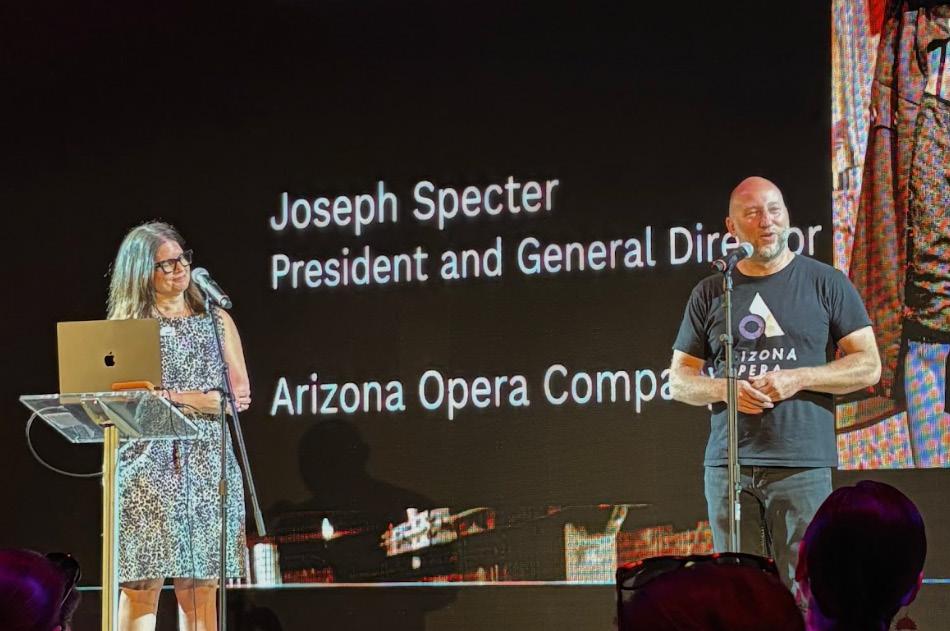
Green Living had a fantastic time attending the annual community meeting for Artlink at the Arizona Opera. The event was a lively celebration of creativity and collaboration, bringing together artists, enthusiasts, and community members. It was a memorable night that showcased the incredible talent and spirit of the Arizona art community!



October 14th
October 14th y Tickets
Pera Club
1 E. Continental Dr, Tempe, AZ 85288 5PM - 9PM
Pera Club 1 E. Continental Dr, Tempe, AZ 85288 5PM - 9PM


https://greenlivingmag.com/events/ best-of-arizona-2024-event/
://greenlivingmag.com/events/ of-arizona-2024-event/

Using decarbonization and energy-related data, Fashion Revolution is replacing its Fashion Transparency Index with the What Fuels Fashion Report and has been tracking its data for the last seven years. The findings? The fashion industry is failing to take action on decarbonization goals.

Nike is under review by smallholder investors for mismanagement of human rights and labor standards in its supply chain. A group of 70 shareholders that own $4.4 trillion in Nike assets are escalating the issue after receiving no response to a letter last year that asks the company to pay millions in back-pay to Southeast Asian supply-chain workers that has been reportedly owed since 2020.

Quicksilver has partnered with French eyewear producer Oceneo to create a 150-pair, limited-edition release of sunglasses created from upcycled damaged wetsuits. The suits were sourced through Quicksilver’s takeback program in six stores on the Basque and Landes coast in France.

unspun’s founders, Beth Esponnette, Kevin Martin, and Walden Lam, created a machine that can weave thousands of yarns into garments within minutes. This innovative technology increases production agility, reduces lag time in meeting the on-demand trends, and reduces overproduction to potentially lower global carbon emissions by 1%.

Team USA appeared in 100% recycled cotton polos from Ralph Lauren for the 2024 Summer Games in Paris, representing a major departure for the fashion company. Previously made from virgin cotton, according to the brand, the polos took years of research and it hopes to signal to the industry that a shift to recycled materials is possible.










BY ANNA DORL
As consumers consider sustainable fashion, their support of its continued presence has kept greener choices in clothing on trend, making it increasingly possible (and popular) to purchase products that make less of an impact on the planet. Although different lifestyles and needs make us consider different form and function in the items we purchase, if you’re reading this, we can most likely agree on the importance of sustainability. Whether you’re heading to work or back to school as autumn emerges, it’s likely that you’re searching for outfit staples and statement pieces. Here are a handful of some standout items this season to freshen up your look as the air (hopefully) starts to cool down.
Perfect for both everyday use and occasional adventures, the Kuna Crossbody Bag by Torrain is built with an “overflap” to keep all of your stuff safely inside. This bag style’s bold colors and patterns are eye-catching and interest-piquing, like its topography and fish prints. Its single shoulder strap can be adjusted for length. Torrain’s unique products are constructed from upcycled bags that previously held materials like animal feed and cement mix. As a result, the bag is easy to clean and use, and fun to look at. On the inside of each purse, recycled plastic bottles find a new life and a purpose. www.torrain.org
Whether you plan to traipse through the woods on nature walks this autumn or just go back and forth between work and home, you may need a new pair of shoes. Nisolo’s Go-To Lug Chelsea Boots (sold in black and gray) could be an eco-conscious investment for your closet. Inside, each shoe has a memory foam Cellfit™ insole; externally, each includes an XL Extralight® treaded EVA lug sole. These all-weather, lighter-weight boots are crafted with upper leather certified by Leather Working Group, a notfor-profit that drives best practices and positive social and environmental change for responsible leather production. As shoes go, vegans may want to opt out. But, as Nisolo explains further, these boots are made with “100% Living Wages” and “0% Net Carbon.” www.nisolo.com


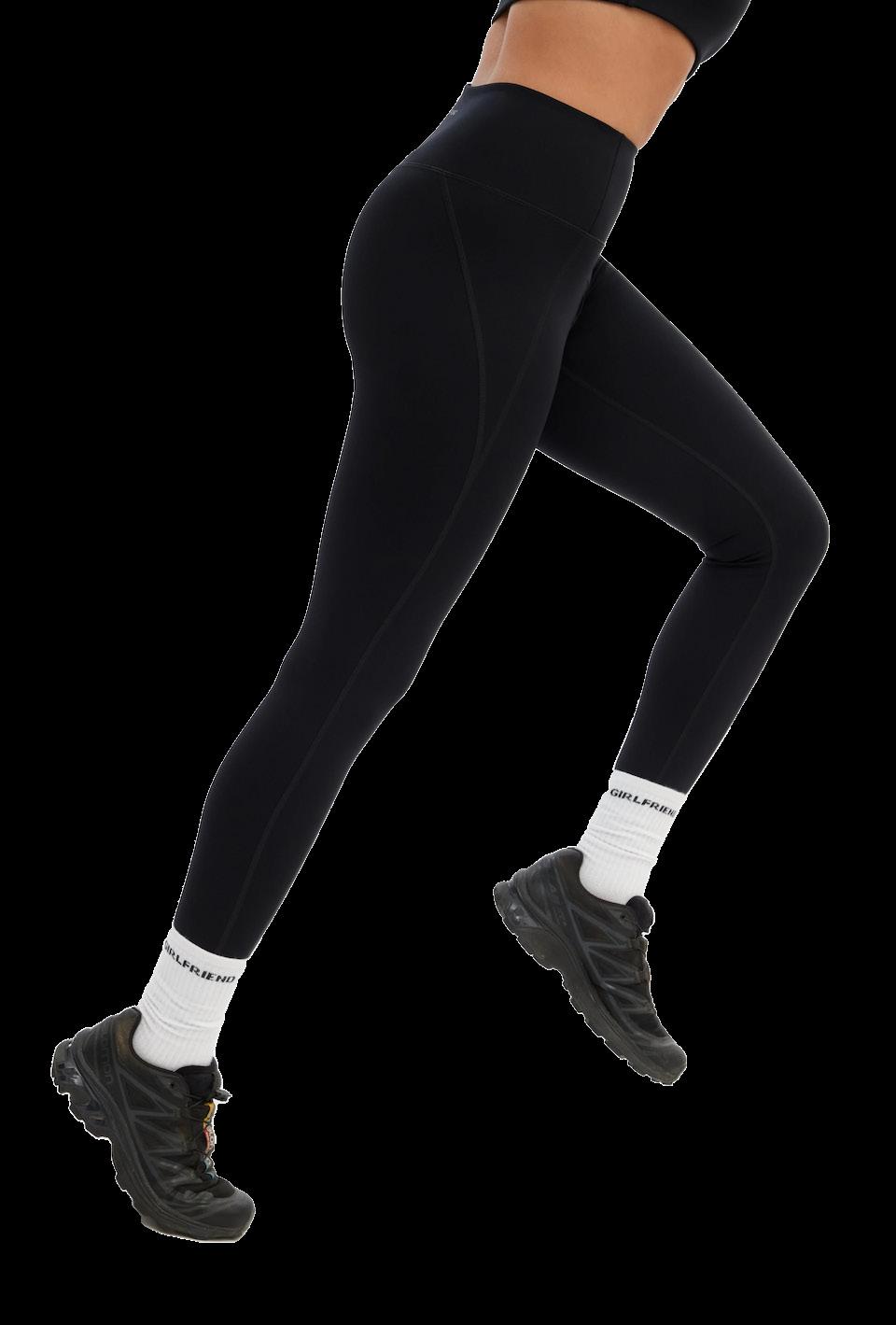


Once autumn arrives, many shoppers find themselves in need of a new pair of leggings. Instead of running to purchase the latest popular pairs from fast fashion brands, consider a company that puts the planet first. The brand — whose recycled fabrics are certified STANDARD 100 by OEKO-TEX — emphasizes, "old water bottles and fishing nets look better on you than they do clogging landfills and polluting oceans.” The Compressive High-Rise Legging is a classic clothing staple created from 25 recycled water bottles and is the company’s self-described “number one seller.” This compressive style comes in multiple color choices, as well as size options from XXS through 6XL. www.girlfriend.com
Although fall is fast approaching, many people in warmer climates are still able to enjoy the carefree fashions of the summer season. The Petra Recycled Linen Top (pictured here in Azure; also available in Pearl) by Yellow The Label is an airy top created with recycled lined linen. This piece captures a casually sophisticated look all while being eco-conscious. Its soothing color scheme is perfect for the sometimes-stressful transition from late summer into early fall. Yellow The Label’s dedication to slow fashion underscores its brand identity, including items made with sustainable fabrics in factories that hold ethical certifications. www.yllwthelabel.com
For those fully embracing the chilly weather to come, this piece is perfect to add to your autumnal outfit roster. The True Knit Sweater by Organic Basics is composed of GOTScertified organic cotton, and its simple flat-knit style and availability in a handful of colors only increases its appeal. For each item on its website, Organic Basics also lists the total carbon footprint of the item across its supply chain, cataloging raw material production and extraction, final assembly, packaging and transport. Organic Basics even offsets its own carbon emissions through a partnership with One Carbon World and calculation help from Made2Flow. www.us.organicbasics.com
Demetrius Douglas is running toward a sustainable and fashion forward future
BY SHELBY TUTTLE
FFABRIC’s annual spring reFABRICate Fashion Show is more than just a runway event; it’s a celebration of creativity, sustainability, and community. Each year, this extraordinary showcase transforms discarded denim into high-fashion masterpieces, challenging the perception of waste and inspiring a new generation of eco-conscious designers.
In recent years, reFABRICate has placed a spotlight on denim, an industry staple notorious for its environmental impact. By partnering with local organizations like Tempe Marketplace, Goodwill, Dave & Busters, and Green Living magazine, FABRIC mobilizes the community to repurpose unwanted denim clothing and cutting room scraps.
These discarded items are then given new life in the hands of talented designers like Demetrius Douglas, a local emerging talent and the winner of the reFABRICate “RunzWithScissors” award. Douglas, whose winning piece he calls “Denim Vest Trench Cloak,” wanted to design something wearable yet eye-catching.
Douglas says that he wanted “a piece that could be practical in the right setting but also appreciated as art.”
Although he grew up with a “deep passion for fashion,” Douglas notes that he’s only been officially designing since May 2023, when he began what he calls an “antisocial experiment.”
“I made a deliberate choice to buy a sewing machine, retreat from the world, and focus on creating,” he said. “I didn't design with trends or public opinion in mind; instead, I dedicated





habitatcaz.org/cars


myself to crafting pieces that resonate with my unique sense of art and expression.”
reFABRICate’s “RunzWithScissors” award is a tribute to the late Astrid Olafsen, a visionary sustainable fashion designer deeply committed to FABRIC’s mission. Olafsen's legacy lives on through this award, which recognizes creativity and talent that proves sustainability can be synonymous with style.
As an event overall, reFABRICate strives to be more than a fashion show, inspiring a call to action for individuals and businesses to rethink consumption and embrace circular economy principles. By showcasing the incredible potential of upcycled denim, the event proves that fashion can be both beautiful and responsible.











BY KATARINA GUENTHER
PPurchasing a garment made from recycled plastic bottles can lead many consumers to feel they are making a positive and sustainable choice, but is it a form of greenwashing? According to a 2019 study published by Reuters, every minute over one million plastic bottles are purchased in the United States alone, with 1,500 of those bottles consumed each second.
With plastic water bottles being a heavily consumed product that takes almost 450 years to break down, reusing that waste to keep it out of landfills is a huge goal for the eco-conscious community. Enter a fashion industry innovation to repurpose plastic water bottles into rPET (Recycled Polyethylene Terephthalate) fabric.
Though the production of materials made from recycled bottles seems to be a simple process, turning the material into its final form can cause concerns. The process of deconstructing plastic bottles most
often used is called mechanical recycling, which involves melting the plastic into a liquid form. The liquid is then extruded into long filament fibers and cut into smaller pellets. According to Marina Liao from The Zoe Report, a fashion, beauty, and lifestyle publication, these pellets are used by a yarn or fabric mill to convert them into a final product with brands such as The Girlfriend Collective and Repreve.
ARE THERE HEALTH AND ENVIRONMENTAL CONCERNS ASSOCIATED WITH rPET POLYESTER?
Converting the recycled bottle into usable material is not toxic on its own, but the processing methods such as dying and adding finishes such as antimicrobial and hydrophobic coatings to the material may create hazardous working conditions in addition to adding chemicals to the clothing, which make them potentially unsafe for the wearer. Without proper oversight and certifications in manufacturing, consumers may be led into false comfort in the purchase of certain recycled plastic garments, believing that the garment is both less toxic and less wasteful.
While the use of post-consumer plastic water bottles in fashion has created a major milestone to keep them from ending up in landfills, it doesn’t necessarily prevent the clothing from eventually ending up there — although brands such as ADAY and Reformation have take-back programs to keep the circularity of the item alive. Disappointingly, certain brands have also been known to source virgin plastic bottles to create rPET polyester due to its reduced cost.
To address both toxicity and waste concerns, certain certifications exist to protect against negative supply chain management, prevent greenwashing, and provide peace of mind to consumers. Names to look for include the OEKO-TEX STANDARD 100, which tests all aspects of a garment for hazardous chemicals, and SA8000, which protects workers across the globe from unsafe working conditions and standardizes worker wages. Finally, the Global Recycled Standard certification helps ensure that suppliers do not use virgin plastic and only collect and recycle the water bottles used for yarns. According to Liao, these
are just a few of the measures that brands can take to reduce the potential health and environmental concerns associated with rPET garments.
Other considerations for all garments produced from synthetic fibers include the product use and life cycle. It is nearly impossible to tell how much microplastic in our oceans is caused by garment washing, compared to single-use packaging or other sources. However, the use of a microplastic filter or a garment wash bag (we like Guppyfriend) can significantly decrease the amount of microplastics released into waterways. While washing machine filters capture microplastics before they enter your drain, garment bags can reduce the friction of clothing fibers when washing and also capture microfibers bound for our waterways.
Additional ways to reduce microfiber shedding in synthetic fabrics when washing include washing items in cold water, using front-loading washing machines or those without agitators, and washing clothes less often. Of course, consuming fewer garments, shopping second-hand, and upcycling your clothing are great ways to reduce your overall environmental impact when it comes to fashion.
And when it comes to shopping for garments that use rPET fibers, there’s no need to feel guilty. Instead, opt to consider where the item comes from, what you can find out about the maker’s manufacturing practices, and whether another article of clothing might be better for you and the environment. There is no perfect answer to these questions, but they can leave room for more research, innovation, and understanding.

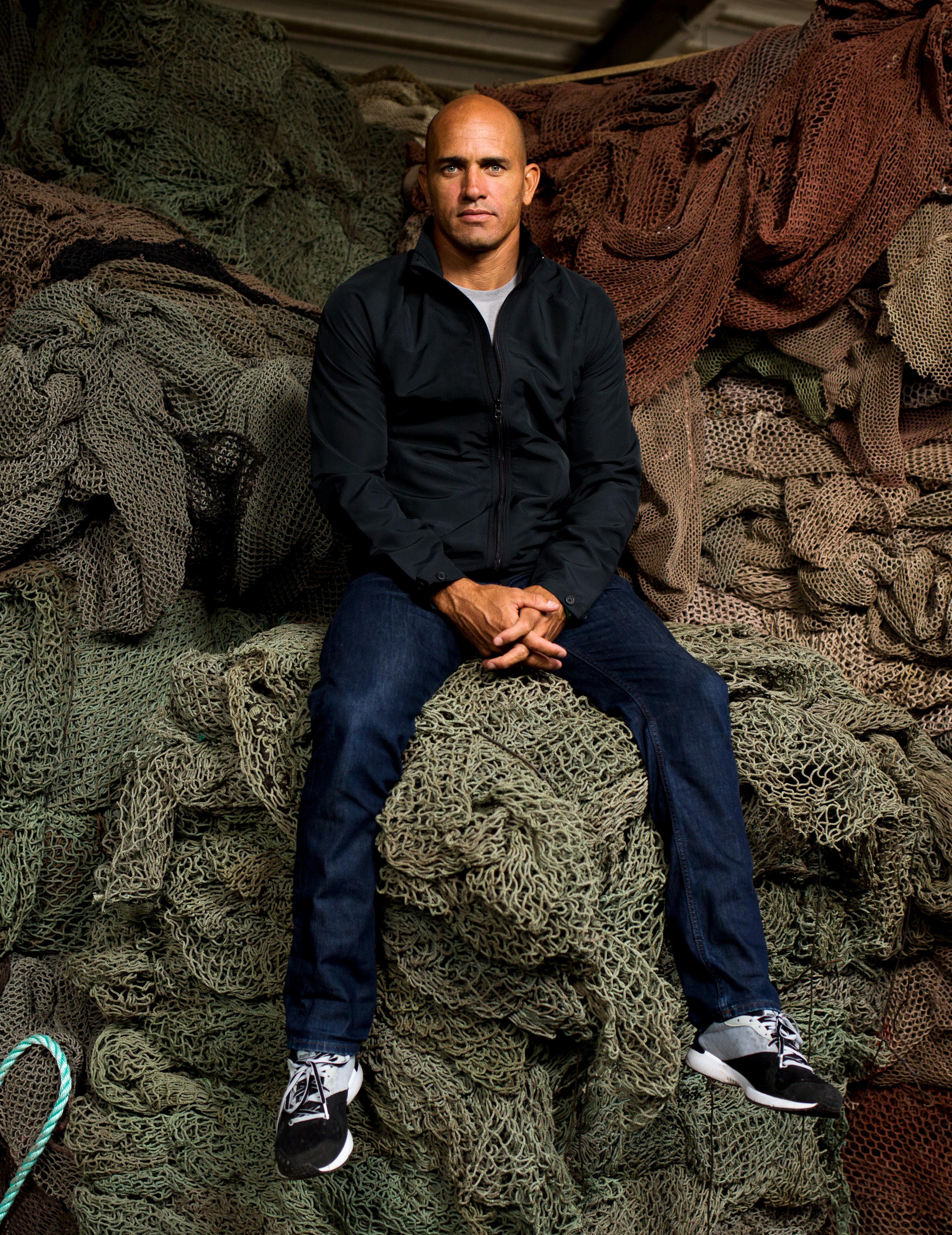
BY SHELBY TUTTLE
AAs an 11-time World Surf League (WSL) Champion, Kelly Slater is widely considered the greatest surfer of all time. In his illustrious 34-year career, Slater has traveled to some of the world’s most scenic and remote locations to surf waves that few dare dream of.
From the thick, deadly waves of Hawaii’s Pipeline and the glassy, heavy barrels of Tahiti’s Teahupo'o, to the fast, left-breaking peel of Fiji’s Cloudbreak, the waves Slater has surfed each offer their own beautiful complexity, naturally shaped by their environment. Among them, however, Slater has noticed one disheartening commonality.
In a 2019 podcast interview on The Sea Has Many Voices, Slater said, “When I used to go to France in the late 80s, early 90s, there was so much plastic in the water. There were so many plastic bags and so much crap in the water. I remember at one point surfing and thought if I fall and I get a mouth full of water, I might choke on a plastic bag.”
He notes that the pollution in that particular region has gotten better over time, but areas like Central America and Japan remain among the worst regions for ocean pollution that he’s witnessed during his time as a professional surfer. It’s easy to see that Slater’s connection with the ocean is profound, and that the challenges facing our environment weigh on his psyche.
Increasingly throughout his career, Slater began to contemplate the ecological impact of his sport. A lifetime spent in the ocean had cultivated a deep
respect for the planet. In his growing environmental consciousness, he began to question the boards that he rode and clothes that he wore, working to gain a deeper understanding of a typical supply chain and the consequences — both human and environmental — associated with it.
He tells me, “As a lifelong surfer, I’ve seen how much pollution humans have made around the world and have come to understand how negatively impacting clothing and especially fast fashion — and space labor — have been on our world. And so, challenging the norms of the industry to show that there is a better way to make clothes was a critical issue for me personally.”
For 23 years, Slater was sponsored by surf clothing giant Quicksilver — a partnership that was as synonymous in the world of surfing as Tiger Woods was to Nike in golf. In April 2014, Slater ended his relationship with the brand, effectively terminating one of the longest-standing sponsorships in the sport.
In a letter to fans on his Facebook page, Slater said, “For years I’ve dreamt of developing a brand that combines my love of clean living, responsibility and style. The inspiration for this brand comes from the people and cultures I encounter in my constant global travels and this is my opportunity to build something the way I have always wanted to.”
He used the opportunity to announce a new partnership with The Kering Group (owner of luxury brands like Gucci, Saint Laurent, and Balenciaga), which would help him launch his now successful clothing brand, Outerknown. But The Kering Group was just a small piece of the puzzle. Slater tapped fashion industry veteran and creative designer John Moore as his co-founder, whose shared love for the ocean and passion for sustainability made him Slater’s perfect partner.
A seasoned creative with a penchant for innovation, Moore has been shaping the fashion industry for over two decades. Recognized as one of GQ’s Menswear Designers of the Year in 2014, his resume includes building iconic brands like Hollister for Abercrombie & Fitch and being selected as a Fellow for the first Levi Strauss & Co. “Collaboratory” in 2016, where he was invited to collaborate with other like-minded industry executives on environmental solutions for their organizations.
As Outerknown’s creative visionary, Moore drives design and storytelling, while leading his team to investigate sustainable practices and fabric innovations that make Outerknown a pioneer in its field.
“It’s been more than a decade since we committed to building Outerknown differently. Over this time, we’ve seen the sustainable conversation increase and messaging around responsible innovation show up across marketing industry-wide,” Moore said. “That’s positive, but there’s a big difference between talking, marketing, and actually doing the work.”
Slater notes that Outerknown’s collaborations with like-minded partners is crucial, and that when creating their products, they look for people and companies who are breaking new ground.
“When you have an idea, you have to start somewhere. And although it might not be perfect, you start to find the right partners and people and ideas through the experience to streamline the process.” He continues, “I’m proud that every step of our process meets the standards and ideals we founded the
company on.”
Those ideals, of course, include the company’s mantra of taking care of both people and the planet. Outerknown was the first brand to be certified by the Fair Labor Association before ever creating a single product.
“Every decision we make — from selecting suppliers to building new products — keeps workers’ rights and safety top of mind,” Slater says.
A key component to upholding the company’s mantra involves the materials sourced to construct its products. Recycled wool, cotton, and polyesters are used across Outerknown’s collections and Moore notes that natural materials take precedence whenever possible. When synthetics are necessary for items like performance board shorts, the team works diligently to source recycled materials.
Moore shares, “A few years ago, we offered the world’s first Merino wool boardshort. It was a great idea, and I loved it, but it didn’t sell well because it lacked many of the performance factors necessary for movement and durability.”
Moore also says that Outerknown’s preferred fiber (organic, recycled, or regenerated) usage improved from 95% in 2022 to 99% in 2024, and that the company works hard to avoid the use of fibers like virgin polyester, virgin elastane, and virgin cotton. The company’s internal fiber policy and scorecard guide the considerations for preferred fibers based on sustainability and circularity potential. At Outerknown, organic cotton, recycled cotton, Regenerative Organic Certified® cotton, hemp, and responsible and recycled wool reign supreme. Notably, the company has outlined a plan to achieve full circularity by 2030.
Of the upcoming Outerknown fall and winter collection, Moore says he is most excited about their line of sweaters made in Italy and Romania which use wool that has been sorted by color and broken down by hand, so that new recycled wool yarns can be spun in the same colors without using harmful dyes or chemicals. This process also helps to divert pre- and post-consumer virgin wool textiles from landfills by putting this valuable fiber back into circulation.
“There’s also a bio-fiber blend that we’re sourcing from the ocean and putting into one of our most important products for later this fall,” Moore notes.
“Being surfers, this innovation hits squarely at home since it comes from the ocean. I can’t talk about it yet,



but we’ll be the first to market with this, so [I’m] very proud of the team’s effort to bring this to life.”
Slater notes that he is excited to be working toward creating high-quality, responsibly made pieces that are also affordable.
He and Moore aren’t shy about addressing Outerknown’s price point (the brand’s signature Blanket Shirt is priced at $168), which is considerably higher than most surf brands — but then again, Outerknown isn’t really a surf brand. As I lazily thumbed through various racks of Blanket Shirts neatly hung on sustainable hangers at Outerknown’s store in Malibu, it was easy to see that Outerknown is a lifestyle brand all its own. Without a doubt, Slater’s fame naturally garners an affinity for his brand within the surfing community, but overall Moore notes that Outerknown’s customers are those who want to purchase clothing that aligns with their values.
“They are willing to pay the additional cost associated because they see it as a long-term investment,” Moore says. “For the
industry to truly catch up, this cost of buying responsibly needs to continue to come down. A cultural shift in consumption is necessary so that more businesses view sustainability as a business opportunity.”
To address the high environmental costs of consumption, the team at Outerknown has also created Outerworn, a pre-owned marketplace hosted on Outerknown’s website, where fans of the clothing can purchase and sell pre-loved Outerknown items.
And when it comes to helping other brands recognize the benefit of sustainability in business, Slater and Moore aren’t selfish or secretive about Outerknown’s sustainability processes and want other companies to benefit from their research.
“Even though it takes time and discipline to build a responsible supply chain that takes care of its workers, we know that this model causes the least harm,” Slater says. “[We] have made our processes transparent so that other companies can use Outerknown as a resource and an inspiration.”
Moore echoes his sentiment. “If Outerknown, as an emerging brand with no prior experience, can do it — this should be a model for the industry that businesses

big and small can do it, as well.”
Outerknown has often voiced its desire to better reach the surf crowd with price points that can more closely compete with traditional surf brands. When Outerknown first launched, the brand was carried on high-end websites, most likely due to its launch with The Kering Group. But as the brand has expanded into nine brick-and-mortar locations across the country — many in popular surf spots — it's a clear opportunity for Outerknown to capitalize on a would-be built-in demographic, if not for what some may view as a price barrier.
Newly minted CEO of Outerknown Dylan Slater (no relation to Kelly) confirms, “We are working on a product line in collaboration with Kelly for a to-be-announced future season. We are excited to bring a fresh approach to product(s) within the surf market, which will be delivered at a price point tailored to the surf specialty retail channel.”
to use that make them stronger and last longer.”
He notes that the environmental synergies and philosophies of all three companies allow them to draw on research, materials, and experience to build the best products in the most responsible way.

In May, Dylan Slater was named CEO of the new holding company that unites Outerknown, Firewire Surfboards, and Slater Designs under one roof. Kelly Slater became the majority stakeholder of Firewire Surfboards in 2015, where he is also able to showcase his own line of surfboards made in collaboration with some of the world’s best shapers at Slater Designs. Prior to the purchase of Firewire, Kelly parted ways with longtime board sponsor Channel Designs, citing overall concerns about how surfboards were made and the environmental legacy they left behind.
Of the boards made at Firewire, Dylan Slater shares, “Our surfboards are constructed using bio-resin, which produces a reduced carbon output by 30%.” He continues, “We are constantly looking for new materials
At the time of writing, Slater is currently in Fiji as a wildcard entry for the last stop of the WSL’s regular season. As he missed the mid-year cut for the second half of 2024, the event is speculated to be Slater’s last hoorah — the perfect way for him to go out with a bang, in his favorite surfing destination of all time. At 52, Slater has won the Fiji Pro four times. Of his 11 world titles, he also holds the record for being both the youngest and oldest professional surfer to win a world surfing championship at ages 20 and 39. He has competed in a reported 280 World Tour events and claimed 56 Championship Tour wins.
As the competition opens, onlookers wait with bated breath to witness surfing’s G.O.A.T. in the most fitting of potential finales. But certainly, Slater will not simply fade into the sunset. He is a force to be reckoned with, not just in the world of surfing, but also in business and certainly, environmental stewardship. He’s made caring about the environment cool, and thus, raised the bar not only for consumers, but the fashion industry as a whole. As with surfing, Slater seems poised to leave a lasting legacy in his next chapter of life, as well.
“I wanted to have Outerknown reflect and implement my beliefs and use it as a means to communicate deeper values,” he says. “I think that every small improvement we make has a big impact — for people and the planet.”
For more, visit www.outerknown.com.
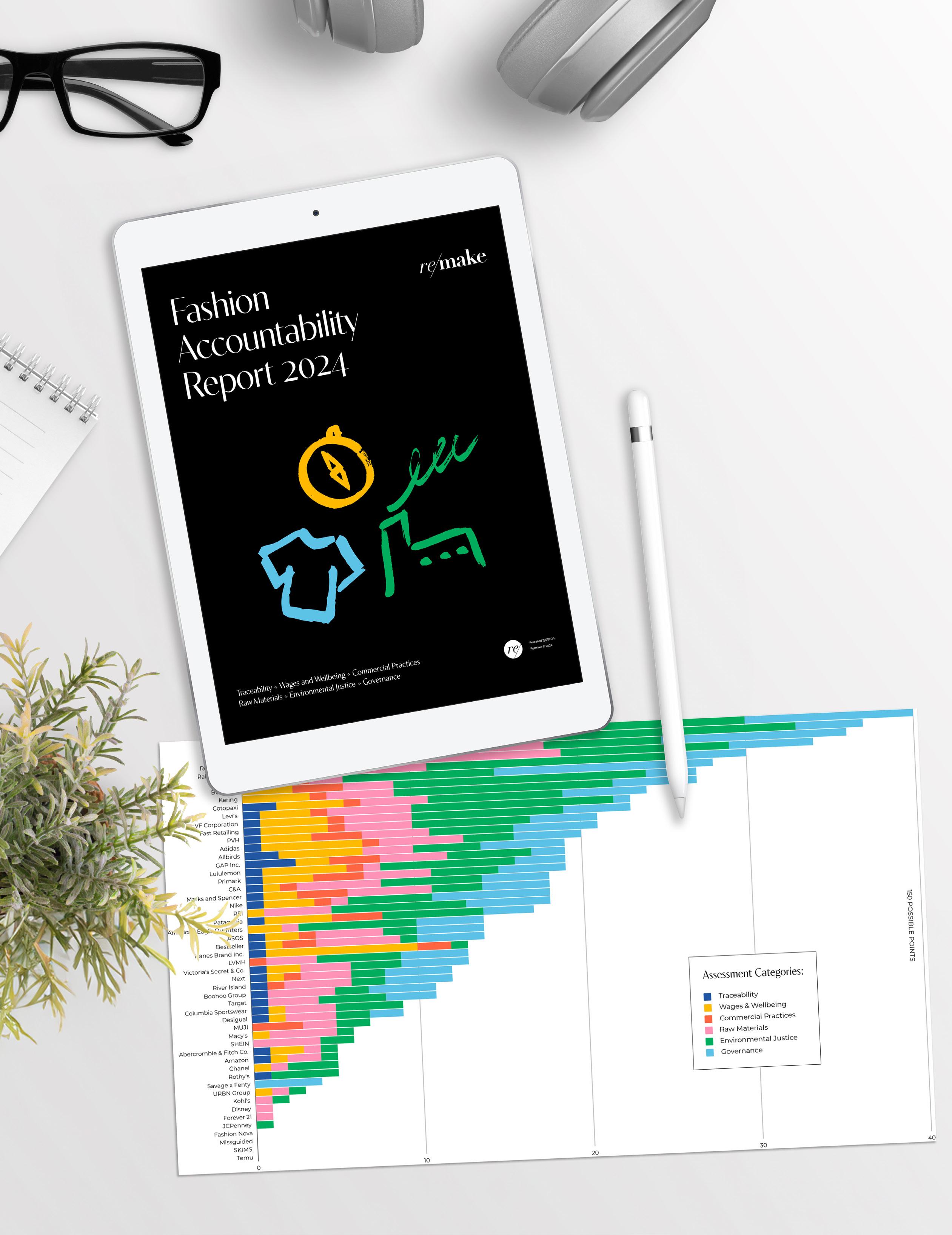
Report and chart courtesy of Remake.

BY COLLEEN KERN
TThe fashion industry, celebrated for its creativity, carries a heavy burden of responsibility for its impact on both people and the planet. Fashion accounts for up to 10% of global carbon emissions – surpassing the combined output of all international flights and maritime shipping. It's a thirsty industry, too, with a single cotton shirt guzzling the same amount of water that one person drinks in 2.5 years. Our throwaway culture exacerbates these issues, sending 92 million tons of clothing to landfills annually.
Beyond the environmental toll, the social costs are equally alarming, from poverty wages to unsafe working conditions in garment factories worldwide. To address these challenges, Remake, a non-profit organization, strives to transform fashion into a force for good. Their annual Fashion Accountability Report offers a holistic evaluation of companies' progress towards social and environmental responsibility.
The 2024 Remake Fashion Accountability Report has evolved to provide a more comprehensive assessment of the fashion industry. This year's report has expanded its coverage to 52 companies with annual revenues over $100 million and includes several new additions. The methodology has been refined, with tightened criteria and a focus on demonstrable progress rather than hollow promises.
With a possible total score of 150 points across six categories (Traceability, Wages and Wellbeing, Commercial Practices, Raw Materials, Environmental Justice, and Governance), the average company score was a mere 14 points – unchanged from the previous year despite mounting pressure for reform.
Leading the pack, Everlane claims the highest score with 40 points, followed closely by H&M Group at 37 and PUMA at 36. Rounding out the top five are Reformation (34 points) and Ralph Lauren (30 points).
Everlane, often touted for its commitment to "radical transparency," seems to be putting its money where its mouth is. The company demonstrates progress across all categories, with particular strength in traceability and environmental justice initiatives. They've made significant strides in adopting more sustainable materials and have committed to sourcing the majority of their natural materials from regenerative or beneficial sources by 2025.
H&M Group's second-place ranking might raise eyebrows given past controversies, but the report acknowledges the company's efforts, particularly in emissions reduction and chemical management. The company has also begun investing in suppliers to guide the co-creation of strategies to reduce emissions, a crucial step towards meaningful climate action in the fashion industry.
At the other end of the spectrum, Fashion Nova, Forever 21, JCPenney, Missguided, SKIMS, and
Temu all received zero points across all categories, indicating a complete lack of transparency or demonstrable progress on sustainability issues. Perhaps most alarming is the presence of some ostensibly "sustainable" brands near the bottom of the rankings. Rothy's, known for its recycled plastic shoes, scored only 5 points. This low score highlights the gap between marketing claims and actual verifiable progress in sustainability practices. Savage X Fenty, Rihanna's lingerie brand that has garnered praise for its inclusivity, managed just 4 points –and those solely in the governance category. This underscores the importance of looking beyond a single aspect of sustainability and considering a brand's overall impact.
We’ve organized the report findings into three main categories:
• Social Impact: Only 2 out of 52 companies disclosed the percentage of garment workers receiving living wages, while 17% revealed unionization rates in their factories.
The report paints a concerning picture of the fashion industry's approach to worker well-being. Only one company, Puma, stated it paid living wages to all direct employees globally. Few companies demonstrate tangible efforts to support unionization or provide adequate grievance mechanisms for workers.

Although saddled with a controversial past, H&M Group has shown significant improvement in the areas of emissions reduction and chemicals management. Photo courtesy of H&M Group
• Climate/ Sustainability Impacts: 71% of companies now disclose their total annual carbon emissions, but only 8% have set long-term Net Zero targets approved by the Science Based Targets initiative.
• Commercial Practices and Governance: Not a single company has implemented a Buyer Code of Conduct to hold themselves accountable for fair purchasing practices.
The gap between rhetoric and reality underscores the urgent need for fashion brands to prioritize and substantiate their commitment to worker rights and well-being.
Climate and Sustainability Impacts: Progress and Paradoxes
While awareness of climate impact is growing, concrete, science-based action remains rare. Water usage, a critical environmental factor in fashion production, remains largely opaque, with only three companies disclosing their full water footprint. However, there's a silver lining in chemical management, with 58% of companies adopting a Manufacturing Restricted Substances List to reduce hazardous chemicals.
The much-touted concept of circularity in fashion shows promise but falls short of transformative change. While initiatives like resale and recycling are growing, they have yet to significantly displace linear production models.
Commercial Practices and Governance: The Need for Accountability
Only 4% of companies included responsible sourcing timeline considerations in their order
planning, revealing a widespread neglect of ethical considerations in core business operations. While 62% of companies publish full Tier 1 supplier lists, transparency decreases significantly further down the supply chain.
The report also highlights a concerning lack of progress in diversity, equity, and inclusion efforts. Most companies fail to provide comprehensive data on the hiring and promotions of underrepresented groups.
It’s important to note that Remake's report isn't intended to be a shopping guide; it's a call for fundamental industry transformation. The organization emphasizes several key areas for change:
• Legally binding agreements to ensure accountability throughout supply chains.
• Tailored decarbonization investments for each production region.
• A shift from overproduction to true circular economy practices.
• Prioritizing a just transition that centers worker voices.
Despite the challenges, some positive trends emerge. Companies like Burberry, Cotopaxi, and H&M Group are expanding repair services, while Everlane and Reformation show progress in adopting more sustainable materials. In governance, five companies – Inditex, Kering, Nike, PUMA, and Ralph Lauren – have begun tying executive bonuses to social and environmental metrics.
2. Become a Remake Ambassador: Take the lead in the #WearYourValuesMovement by educating your community about sustainable fashion practices.
3. Support policy changes: Urge your representatives to support legislation that holds fashion companies accountable for their environmental and social impacts.
4. Use social media responsibly: Follow @remakeourworld on Instagram and TikTok to stay informed and share important information about sustainable fashion with your network.
5. Support Remake's work: Consider donating to fund their research, advocacy, and educational initiatives.

Remake's message extends beyond industry insiders to consumers: "Continue to learn, share and act! Use your voice to push companies to do better! Participate in campaigns and vote for policies that protect worker communities, human rights and the environment. Consider each purchase a long term investment."
But how can consumers put this call to action into practice? Remake offers several avenues for engagement:
1. Join Remake's campaigns: Visit their Campaigns Page to support initiatives like the FABRIC Act, which aims to improve working conditions in the U.S. garment industry.
As we navigate the complex landscape of fashion and sustainability, reports like Remake's serve as crucial guideposts. They remind us that transforming the fashion industry demands more than conscious shopping – it requires engaged citizenship, policy advocacy, and a willingness to reimagine the entire fashion ecosystem. While the journey ahead is long, organizations like Remake are lighting the way toward a more sustainable and ethical future for fashion. By taking action, every one of us can play a part in this vital transformation.
Find the full report at www.remake.world/ accountability-report-2024.

BY ANGELA FAIRHURST

In recent years, the fashion industry has faced increasing scrutiny for its environmental impact. As consumers become more conscious of their ecological footprint, designers and brands are responding with innovative solutions to create more sustainable clothing — and these cutting-edge trends are reshaping the fashion landscape.
ECONYL nylon addresses the problem of existing waste by transforming it into a valuable resource. Developed by Italian firm Aquafil, ECONYL is a regenerated nylon made from recycled waste materials such as fishing nets, carpet fibers, and industrial plastic. This innovative approach not only helps to reduce the amount of waste in landfills and oceans but also provides a sustainable alternative to virgin nylon, which is derived from petroleum.
The process of creating ECONYL is a testament to circular economy principles. The nylon waste is collected, cleaned, and chemically recycled to its basic chemical structure. It's then reformulated into a new nylon yarn that's identical to virgin nylon. Remarkably, this process can be repeated infinitely without loss of quality, making ECONYL a truly innovative material. Several high-profile brands have recognized the potential of ECONYL and incorporated it into their collections.
Gucci: The Off The Grid collection focuses on circular production, incorporating ECONYL to create stylish, eco-friendly products. Gucci's commitment to sustainability extends beyond just materials: the brand is also investing in initiatives that support environmental conservation and social responsibility.
Napapijri: The Circular Series for Napapijri introduced the first of its kind — a reimagined premium jacket line that is 100% recyclable thanks to its mono-material composition. The fillings and trims are made of ECONYL,

making it easy to recycle and regenerate at the end of its useful lifetime. Napapijri launched the collection with a take-back program to encourage consumers to return the jackets for recycling
Prada: The Re-Nylon collection features bags and accessories made from ECONYL, demonstrating how recycled materials can be used to create luxury products, challenging the notion that sustainability and high fashion are mutually exclusive. This collection not only emphasizes style but also promotes environmental responsibility, appealing to a growing demographic of eco-conscious consumers.
The adoption of ECONYL by these prestigious brands is helping to normalize the use of recycled materials in fashion, paving the way for wider industry acceptance and consumer demand for sustainable options.

One of the most exciting developments in sustainable fashion is the use of seaweedbased materials. This innovative approach not only provides an eco-friendly alternative to traditional fabrics but also helps address the issue of marine pollution. Seaweed, a fastgrowing and abundant resource, offers several advantages as a raw material for textiles.
Seaweed requires no fresh water, land, or fertilizers to grow, making it one of the most sustainable crop options available. As it grows, seaweed absorbs carbon dioxide, helping to mitigate climate change through carbon sequestration.
Fabrics made from seaweed are fully biodegradable, which reduces long-term environmental impact. Additionally, seaweed-based fabrics often inherit beneficial natural properties, such as UV protection and antimicrobial qualities.
Materials science company smartfiber AG developed SeaCell, a patented, eco-friendly fiber that combines seaweed with other sustainable materials like eucalyptus. This innovative fiber has limitless applications in textiles, making it suitable for a wide range of uses, from sports and leisure apparel to soft furnishings.
SeaCell fibers are soft, breathable, and rich in nutrients that can benefit the skin. They are also 100% biodegradable, allowing the skin to harness the power of nature through fibers that are abundant in minerals, antioxidants, and vitamins. Several brands and designers are at the forefront of this trend.
Pangaia: This materials science company has developed C-Fiber, a fabric innovation that combines wood pulp and seaweed powder from SeaCell. The resulting fabric is water-saving and biobased, offering a sustainable alternative to traditional textiles.
Pangaia's Lightweight Rib collection, made with C-Fiber, showcases the potential of this material to create soft, breathable, and environmentally friendly garments.
Scarlett Yang: A Central Saint Martins graduate and winner of LVMH's Maison/0 Green Trail Award, Yang combines algae with other ocean-based materials to create her 3D-printed bio-based fabrications. Her designs highlight the versatility and sustainability of seaweed, showcasing how innovative materials can redefine fashion aesthetics.
to produce eco-friendly fabrics for fashion design. Tabinotabi emphasizes the importance of local sourcing and sustainable practices in its production methods, contributing to the preservation of marine ecosystems.
The rise of seaweed-based materials in fashion represents a broader shift towards bio-based, renewable resources in the industry, demonstrating that looking to nature for solutions can lead to innovative, sustainable practices that benefit both the environment and consumers.
Eco yarns are typically made from organic, recycled, or natural fibers, which require less energy and fewer resources to produce compared to conventional yarns. This approach helps to lower carbon footprints, conserve water, and reduce waste. Additionally, eco yarns often involve ethical production practices, ensuring fair labor conditions.

Kerisma Knit: Kerisma Knit is leading the way in promoting sustainability through the use of eco yarns, aiming to create stylish, high-quality garments that align with environmentally conscious values and cater to the growing demand for sustainable fashion.
Tabinotabi: This brand uses SeaCell fiber, incorporating brown seaweeds harvested in Iceland,
Kerisma Knit uses eco yarns that are blends of recycled polyester, wood pulp, and sometimes, elastane. Their eco yarns often contain a significant proportion of recycled polyester, making up about 92% of the composition in some styles, with 5% wool and 3% elastane added for texture and elasticity. For example, the Nash Long Cardi is crafted from 92% recycled polyester, 5% wool, and 3% elastane. Similarly, other products in the eco-yarn collection follow this sustainable approach, blending recycled and natural fibers to create high-quality, environmentally friendly knitwear.
By using eco yarns, Kerisma Knit highlights the importance of using recycled and natural materials to create fashionable, durable, and eco-friendly garments.
3D printing enables designers to create items with precision and efficiency.
In the realm of 3D printing for fashion, two key approaches have emerged. Firstly, 3D bioprinting, which draws inspiration from medical applications, focuses on using biodegradable materials to create fashion items. This technique allows for the production of complex shapes and structures that would be difficult or impossible to achieve with conventional methods. The second, Zero-waste 3D printing, combines additive manufacturing technology with design principles that aim to eliminate production waste, particularly in the creation of accessories and small fashion items. Both methods offer innovative solutions for more sustainable fashion production. Several brands and designers are leveraging 3D printing for sustainable fashion.
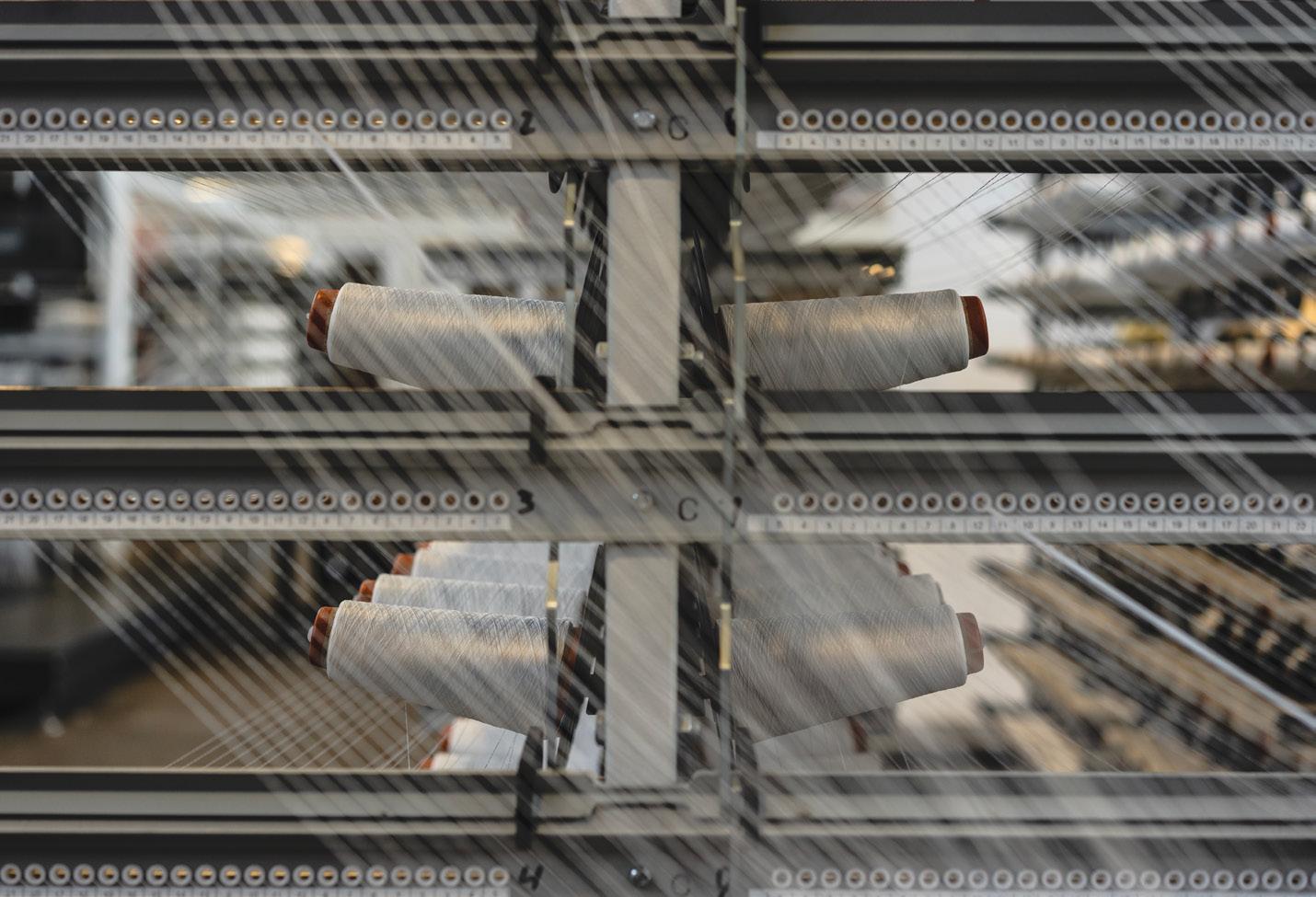
3D printing technology is revolutionizing the fashion industry, offering new possibilities for sustainable garment production. This method allows for reduced waste, on-demand manufacturing, and the use of biodegradable or recycled materials. Unlike traditional manufacturing methods, which often involve significant waste and resource consumption,

Iris van Herpen: Couturier and artist Iris van Herpen was the first designer to use three-dimensional printing to create a complete runway-ready dress in 2011, which was highlighted in Time magazine’s “50 Best Inventions” feature. van Herpen has been pushing the boundaries of the technology ever since — creating printed pieces and hand-stitching them together to create intensely beautiful sculptural garments. In 2018, the Phoenix Art Museum showcased van Herpen’s work through its “Iris van Herpen: Transforming Fashion” exhibit, which featured a beautiful ensemble of 40 futuristic designs.
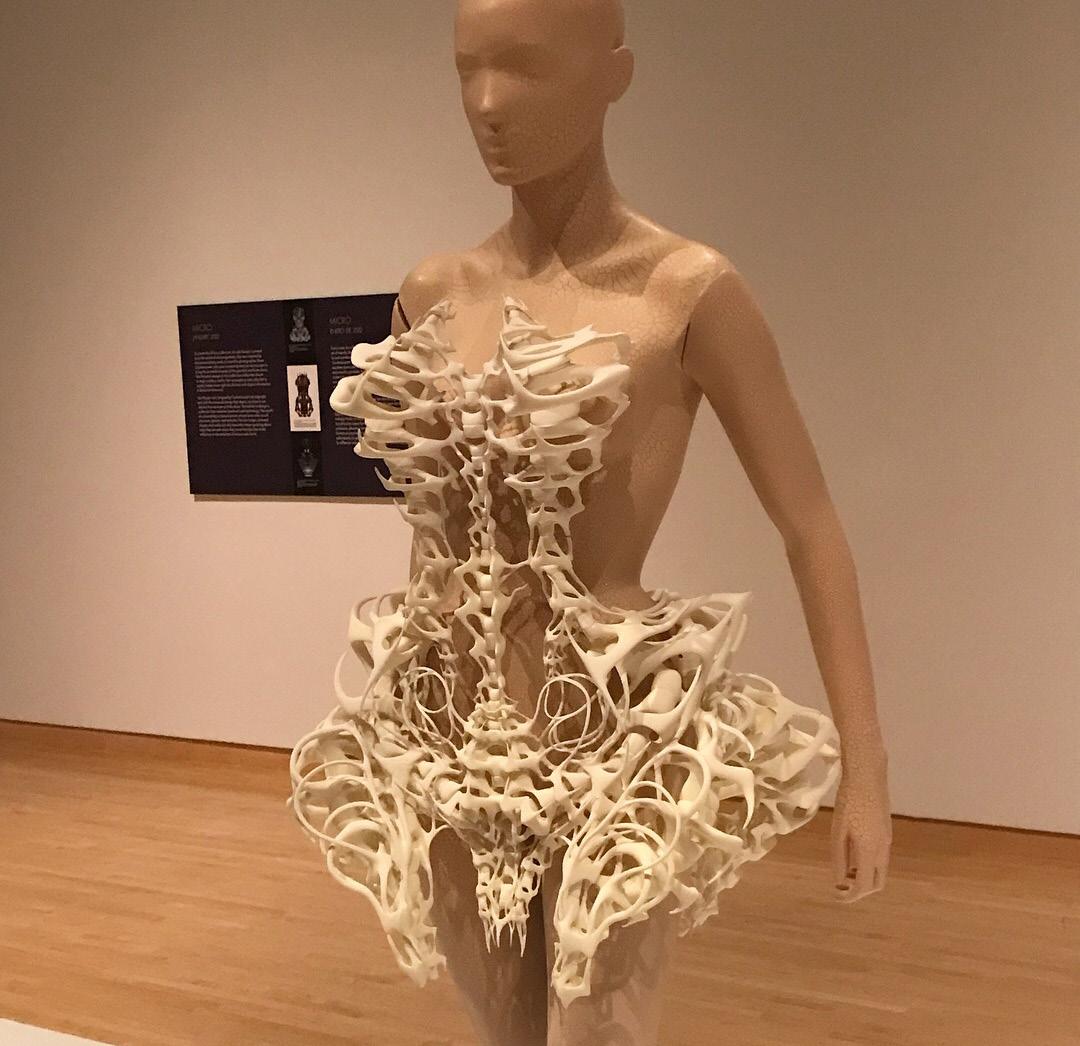
Ministry of Supply: This brand uses recycled materials in their 3D printing process, transforming 1.2 million water bottles into 3D filaments for clothing production, thus addressing both plastic waste and textile production issues.
unspun: A California startup focusing on 3D-weaving technology to create custom-fit jeans with minimal waste, unspun demonstrates how zero-waste principles can be applied to various aspects of clothing manufacturing.
These four trends are part of a larger movement towards sustainability in the fashion industry and are just the beginning. Other emerging trends include:

• Advanced fiber recycling technology to separate mixed materials.
• Novel sustainable materials derived from food waste, algae, human hair, and mushrooms.
• Vegan material alternatives such as bio-based leathers.
• Circular economy practices — a closedloop system focused on reducing waste, maximizing resource efficiency, and extending the lifecycle of products through sustainable design, reuse, recycling, and innovative business models.
• Upcycling — the process of transforming discarded or unused materials and products into new items of higher quality or value.
• Slow fashion and minimalism.
• Ethical and transparent supply chains.
• E co-friendly dyes, including bacterial and algae-based options.
Now at a critical juncture, the fashion industry’s growing commitment to sustainability illustrates the ability to balance creativity and style with environmental responsibility. As these technologies mature and become more widely adopted, we can expect to see a significant shift in how clothing
is designed, produced, and consumed. The future of fashion is one where sustainability is not an afterthought, but rather an integral part of the creative process.


BY AARON EAGLES AND SHELBY TUTTLE
AAround the world, September is one of the most important fashion months of the year, where avant-garde designs are debuted by the industry’s most influential designers at the four major fashion week events in New York, Milan, Paris, and London.
This month, Green Living is also celebrating the spirit of fashion — most notably, who to watch when it comes to our state’s own fashion scene. This “who to watch” list includes notable individuals who have long been a part of Arizona’s fashion community, along with some fascinating up-and-comers working to make a name for themselves in the industry.
Founders of Tempe’s “phygital” fashion incubator, FABRIC, Angela Johnson and Sherri Barry are dedicated to democratizing access to the fashion industry. Sustainability is at the core of FABRIC’s DNA, and the work done within their walls is reinventing a traditional (and wasteful) approach to fashion.
Angela shared, “Our vision is to establish Arizona as a modern fashion industry capital for the U.S. by creating a tech-based, sustainable, closed-loop fashion ecosystem that attracts and supports directto-consumer apparel brands. We’re already making significant strides towards this goal, but with additional support, we could achieve even more.”
It’s important to note that FABRIC is actually a nonprofit organization and has also donated over $13 million in no-cost/discounted courses and programs designed to help designers and brands get started and be sustainable while chasing their dreams.

Dennita Sewell has had a significant impact in elevating fashion as an art form in Arizona. She was monumentally instrumental in the formation of ASU’s partnership with Los Angeles’ renowned Fashion Institute of Design & Merchandising, and as ASU FIDM’s founding director, Sewell is also a professor of practice, teaching courses on contemporary fashion. Prior to joining ASU, she served as the fashion curator for Phoenix Art Museum, bringing to life more than 50 exhibitions in just under 20 years. Sewell began her storied career as the collections manager for the Metropolitan Museum of Art’s Costume Institute.
Khamsone Sirimanivong has served as the president of Arizona Costume Institute since 2012. She studied fashion design at FIDM and works on projects dedicated to preserving her cultural heritage both here in Arizona and around the globe. Khamsone was recently a featured contributor for USA Today, where she shared more in-depth details about her life as a refugee and how dressing like a boy simultaneously helped her to survive war in her native Laos and led her to a career in fashion, while using it as a meaningful connection to share her history and culture both with the world and those around her.
Longtime photographer
Chris Loomis is among the Valley’s in-the-know individuals when it comes to fashion. And while he’s typically the one behind the lens, Loomis will launch his own event on September 13 at Mesa Contemporary Arts Museum. Of the show, Chris says, “Our fashion show will be featuring otherworldly plant forms I personally hand built, as well as a costume I created.”
Couture designer Galina Mihaleva doesn’t just create beautiful designs, she also works on the forefront of science and sustainability,

blending technology and fashion to make the wearer more in tune with their surroundings. In addition to designing wearable tech that is both functional and fashionable, Mihaleva owns her own design studio in Scottsdale, where she creates custom couture pieces for the Valley’s elite. Mihaleva is also an associate professor at ASU FIDM.
Leonor Aispuro is never afraid to try something new, do something out of the box, and go against the grain. Using the heritage and traditions of her native Mexican culture as inspiration for her unique design aesthetic, Aispuro bucks the fast fashion trend in favor of sustainable and ethical design. She works to leave no material waste and uses earth-friendly dyes and natural processes when possible. Aispuro has been profiled in Vogue UK, and her work was also featured in Italian Vogue online.

Ruby not only creates absolutely stunning works but is also dedicated to the growth of the Arizona fashion community. Ruby
is a staple within the fashion and art community locally and is always creating something new, usually with sustainability in mind.
She says, “As a custom designer, I always pay attention to what I use, how much I need, so as not to waste. I often utilize all of the fabric, which can include creating accessories with remnants.”
Ruby currently has several projects in the works, one of which includes designing a custom gown for Channel 12’s Krystal Henderson to be worn at Phoenix Fashion Week.
Whether a part of the architecture, business, non-profit, art, or fashion community, you most likely know or have heard of Oscar De las salas. An influencer regularly on the radars of many, Oscar was honored by Phoenix Mayor Kate Gallego by deeming his birthday, June 29, “Oscar Day” in Phoenix to recognize him for his many contributions to the community. Although Oscar now heads up the Southwest client relationships division at Gensler, his early time in the fashion industry includes work as a catalog model, set designer, and stylist, no doubt influencing his exceptional sense of style.
Naiomi Glasses is a seventh generation textile artist and designer who resides on the Navajo Nation in northeastern Arizona. This designer is not only keeping the traditions of her heritage alive, she’s also spreading it around the world in collaborations with brands like Ralph Lauren and in national publications like Vogue, Huffington Post, and Harper’s Bazaar.
in residence, Naomi shares on the website, “When people wear the collection, I want them to feel empowered. I want them to feel confident, and I want them to know they are supporting the work of a Native artist.”
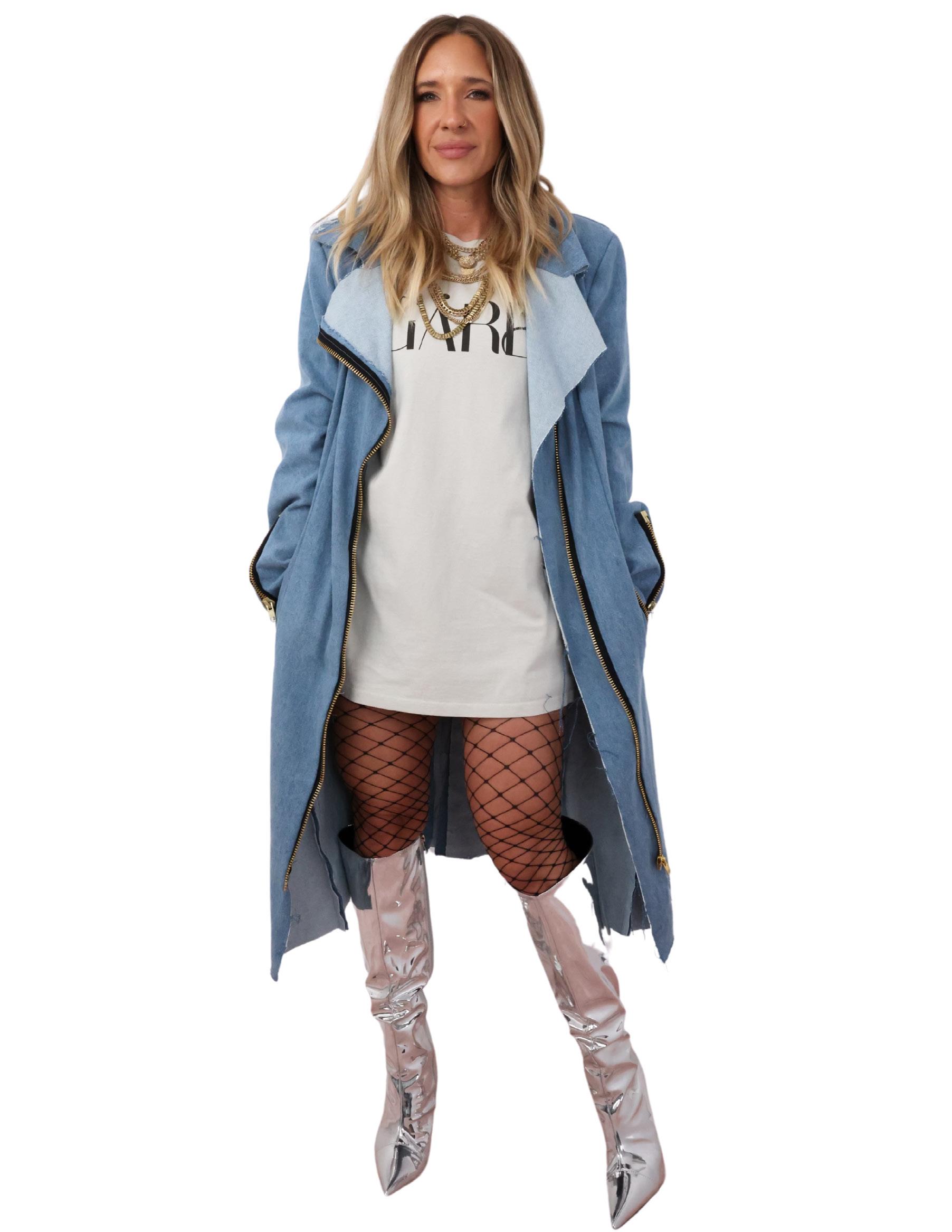
Regarding her collaboration with Ralph Lauren as the design house’s first-ever artist
Katie Anderson may be relatively new to the professional design scene in Arizona, but she’s certainly not new to the industry altogether. Crowned “Outstanding Digital Designer” during Phoenix Fashion Week’s Emerging Designer Bootcamp earlier this year, Anderson is a former wardrobe stylist who grew up with a passion for clothes and even found herself designing as a young child.
She says, “Growing up, I was always altering my clothes — cutting, cropping, adding details.”
In her transition from focusing on her work as a stylist to fullon designer, Anderson recently launched a limited collection of tees and hats for GÄRB — her rocker-chic brand with a selflove message that will officially debut a collection of 10 pieces at Phoenix Fashion Week on September 28.
Anderson says, “We are a rocker chic brand with a mission to empower women to embrace their uniqueness and ignite a spark of self-love.”
With GÄRB’s edgy aesthetic, you might not think that Anderson designs with sustainability in mind — but you’d be wrong.
She notes, “At GÄRB, we keep sustainability in mind by optimizing fabric use and sourcing materials locally, and we do all of our manufacturing in the U.S. We’re also working on a collaboration with a nonprofit to raise funds for planting trees in the Amazon.”

BY ALISON BAILIN BATZ
CChefs know good food, but which local talents are using progressive, sustainable practices to dish it out on a daily basis? Green Living recently had the chance to sit down with several Arizona chefs and restaurant operators to talk in depth about how they’re leading the charge for a greener culinary scene.
According to Executive Chef Christopher George, who oversees each of the four eateries, the local favorites source all of their meat, fish, and shellfish from sustainable sources, ensuring that every dish not only impresses guests but also supports responsible and eco-friendly practices. The restaurants also incorporate low-flow faucets and waterless toilets, along with water-efficient dishwashers and other equipment to help conserve water and reduce utility costs. In addition, the restaurants compost scraps and donate surplus food to local shelters.

Owner Melissa Harlan and daughter Haley, who serves as chef, are exceptionally proud that their gorgeous concept is a Green Certified Business by Local First Arizona. Every tea blend and menu item is carefully sourced from ethical suppliers who share
the same commitment to reducing environmental impact. From organic teas to locally sourced, vegan, and organic ingredients, every cup and tea tray served is a testament to conscious choices that prioritize the planet’s well-being. In a world where dietary preferences often lead to increased food waste, Drink Me! has found a way to cater to diverse needs without compromising on sustainability. The restaurant’s entirely vegan and gluten-free menu not only ensures inclusivity but aligns with a lower carbon footprint, as plantbased options require fewer resources to produce and have a significantly reduced impact on the environment compared to animal-based counterparts. What little waste is produced — including tea leaves, paper products, and food — is composted in partnership with The Orchard Community Learning Center, a local non-profit learning farm in South Phoenix.

This James Beard Award nominee takes great pride in minimizing its environmental impact while providing exceptional dining experiences. In addition to focusing on hyper-local sourcing and offering plant-based dishes to lower environmental impact, according to chef-owner Rochelle Daniel, Atria minimizes waste and diverts organic materials

from landfills by repurposing scrap products. The restaurant also uses energy-efficient appliances and lighting to reduce energy consumption and lower greenhouse gas emissions; has adopted practices to reduce water usage, including low-flow fixtures and efficient dishwashing techniques; and collaborates with suppliers who adhere to sustainable practices, ensuring that ingredients are sourced responsibly. Daniel designed the menu to highlight dishes that use less resource-intensive ingredients, such as grains, legumes, and seasonal vegetables. She also sources seafood from local sustainability leader Chula Seafood and uses biodegradable or recyclable packaging materials for all takeout and delivery services.
Atria has a training program for its staff focused on eco-friendly operations and hosts events that promote sustainability, such as farm-to-table dinners and workshops on cooking with local ingredients. The efforts of Daniel and her team have been recognized with a sustainability award from the city of Flagstaff, highlighting their dedication to promoting sustainable practices in the restaurant industry.
This Arizona icon believes in an all-encompassing sustainability philosophy that touches every facet of the organization. Over the past seven years, according to Chief Culinary Officer and chef Steven Short, Atlasta has successfully navigated how to operate zero-landfill kitchens and zero-landfill events, a true rarity in the industry. Recently, the company eliminated all single-use plastics from its full-service catering division. While recyclable, these items still had an environmental trade-off that Short and his team found unacceptable. Atlasta’s academic and scientific partnerships include teaching senior-level students at ASU’s Global Institute of Sustainability and Innovation and the Walter Cronkite School of Journalism in the areas of business, ethics, and sustainability. Short has even been featured as a subject matter expert at national sustainability conferences, served as a member of the ASU Wellness Committee,





and has participated as a member of the Sustainable Food Task Force that is involved in ASU’s purchasing and sourcing of food. Finally, over the past 13 years, Atlasta has donated over one million pounds of food, which is equivalent to 600,000 meals.

Owner Nicholas Hyche is on a mission to make Der Wurst one of Arizona’s top sustainable small businesses. He currently composts 100% of all food waste and more than 90% of all paper and bar waste. All of his service ware – forks, knives, bar straws, sauce cups, and paper liners – are compostable by design. You won't find plastic of any kind in his

kitchen, save for a very small amount of plastic wrap only used when absolutely necessary. Hyche uses 100% locally made sausages and bread, all from suppliers within five miles of his location. Hyche has also switched to all LED lighting and put all lights on timers; installed low-water usage dishwashers; and 100% of usable food from special events is donated to a local nonprofit that disperses food to those in need in addition to stocking community fridges. Waste items are given to R.City, who turns these items into healthy compost to help improve growing conditions in the desert.

Chef and concept owner Krystal Mack has been deeply committed to making a difference, whether working on her backyard international farm with her mom and dad — digging holes, watering plants, and picking peppers — or recognizing the importance of our planet's future. In seventh grade, Mack and her fellow student council members initiated a program called Flick and Stack, which focused on recycling styrofoam trays from school lunches. These days, Mack’s efforts at Early Bird include a menu that is 100% plant-based, as well as composting 100% of the restaurant’s food scraps with R.City. She plans to source produce grown from the very food scraps that the organization collects. Early Bird was also a key participant in Feed Phoenix, contributing to the 379,679 locally sourced meals delivered to foodinsecure families during the height of the COVID-19 pandemic between 2020 and 2023.



Ingredients
1 1/4 pounds flank steak thinly sliced
1 tablespoon + 1 teaspoon vegetable oil
2 cups broccoli florets
2 teaspoons minced fresh ginger
1/4 cup oyster sauce
1/4 cup beef broth or water
1 cup water
1 teaspoon sugar
2 teaspoons sesame oil
1 tablespoon soy sauce
1 teaspoon cornstarch
1 teaspoon salt
1 teaspoon pepper
1 teaspoon Naija Grille Spice mix (optional)
Directions
Heat one teaspoon of vegetable oil in a large frying pan over medium heat. Add the ginger and garlic to the pan and cook for 30 seconds more. Add the remaining tablespoon of oil.
Season the steak pieces with salt, pepper, and Naija Grille spice mix (if desired) and add the slices to the pan in a single layer — you may need to do this in batches. Cook for 3-4 minutes on each side until browned and cooked through. Set aside.
Add 1 cup water to a small pot and add in broccoli. Cover and allow to steam for 4 minutes. Remove and set aside.
Add the broccoli mixture back to the pan and cook for 2 more minutes or until warmed through. In a bowl, whisk together oyster sauce, beef broth, sugar, sesame oil and soy sauce. In a small bowl, mix the cornstarch with a tablespoon of cold water.
Pour the oyster sauce mixture over the beef and vegetables and cook for 30 seconds. Add the cornstarch and bring the mixture to a boil. Cook for 1 more minute or until sauce has just started to thicken. Serve immediately.


Ingredients
1 lb tortellini (or pasta of your choice)
6 oz salami (or meat of your choice)
6 oz pepperoni
8 oz sliced cherry tomatoes
8 oz olives (Castelvetrano or Kalamata)
4 oz red onions
4 oz sun dried tomatoes (optional)
4 oz sharp provolone
4 oz fresh mozzarella
2 oz fresh basil
6 oz basil pesto
Splash of balsamic vinegar to taste
Drizzle of extra virgin olive oil
Salt, to taste
Pepper, to taste
Grated Parmesan, to taste
Directions
Prepare your pasta per the package instructions. Drain and let the pasta cool completely. Drizzle the pasta with olive oil to prevent sticking and let it cool off in the fridge for at least an hour. Chop up all other ingredients. After the pasta has cooled, remove the cold pasta from the fridge and put in a large mixing bowl. Add all chopped ingredients and mix well. Set in the fridge for another 30 minutes to let the flavors meld. Sprinkle with Parmigiano for an extra layer of flavor and serve. Buon Appetito!

BY ALISON BAILIN BATZ
CCertainly, many resorts – those across Arizona included – have basic sustainability programs in place. But who is going beyond the basics, putting real time, energy, and strategy into eco-friendly practices?
Here’s a look at some Arizona resorts doing far more than simply reducing, reusing, and recycling:
Code Green, Harrah’s Ak-Chin Casino’s sustainability initiative, is inspired by the Ak-Chin Indian Community's deep roots in farming and agriculture and passion for protecting and sustaining land, air, and water. In addition to reducing the property's carbon
footprint, the sustainability efforts focus on energy savings, water consumption, and recycling.
The Code Green team at Harrah’s Ak-Chin believes in providing real solutions to the world's environmental and sustainability challenges and encourages others to do their part. In 2023, team members were involved in highway cleanups and garden replanting activities and even ran an educational booth at a Tribal environmental forum.

A highlight of the year was the Arbor Day tree planting and seed exchange ceremony, attended by many team members to show appreciation and respect for the Earth and Native traditions.
Harrah's Ak-Chin Casino is also part of Clean the World, a global health initiative committed to improving the quality of life for vulnerable communities. In addition to recycling and distributing soap with the non-profit to prevent unnecessary deaths from hygiene-related diseases, the property also organizes community sustainability events, including building hygiene kits for those in need.
Conservation is at the core of the hotel's energy management system. When rooms are unoccupied, air conditioning is set to 75 degrees, and refrigerators are set to low energy use. Low-flow shower heads and faucet aerators help decrease water consumption on the property. Guests are encouraged to reuse towels, and sheets are changed only upon request or after the guest checks out. On the gaming floor, Harrah's Ak-Chin Casino is focussed on improving air quality through cold plasma ionization bars that kill viruses, bacteria, and mold. UVDI purification units also enhance the quality of air and keep guests healthy

through multi-stage filtration. Additionally the property provides eight free electric vehicle charging stations for guests.
When this Tucson icon opened in 2005, it donated 150 acres of pristine Sonoran desert to the Tucson Mountain Park, and by 2008, the resort increased that amount to 330 acres to be forever preserved.
In addition, the resort allocates a portion of its sales to conduct research on mountain lion populations, implement measures to control buffelgrass — a non-native species of plant that increases the threat of fire to our Sonoran Desert — and to build trailheads and create signage in Tucson National Park.
All washes on the property have been preserved and kept intact to allow the free flow of water from the upper desert to lower desert, thus fulfilling JW Marriott’s commitment to allow aquifers to be replenished and to preserve natural highways for desert animals. The resort participates in xeriscaping as well, as a means to save this valuable desert resource.
The resort works closely with the Agua Linda CSA, an organic grower that practices sustainable agriculture free of any GMO or
use of engineered seed crops, and the team has committed to purchasing humanely treated animals free of any additional hormones or antibiotics as they are available.
Visually, guests will notice that the resort maintains an organic garden outside of Passagio Restaurant which provides ingredients for the eatery’s use. Waste from kitchens throughout the resort is composted on property into nutrient-rich organic soil used in the garden.
And the golf course? All golf course irrigation is completed using reclaimed water, with no ground water used to water the course. Starr Pass Golf Club overseeds fairways and tees only during the winter months. By allowing the roughs to go dormant, the property saves millions of gallons of water each year.
In partnership with Alvéole, an urban beekeeping organization devoted to reconnecting people in cities to nature, Andaz Scottsdale launched a beekeeping program in 2023. As part of the program, the resort has established a beekeeping operation on the property, complete with a new hive that is home to more than 7,500 bees.

As a result, guests can enjoy honey-centric menu items at Weft & Warp Art Bar + Kitchen, the resort's on-site restaurant, which serves modern Mediterranean cuisine and artfully crafted cocktails. Additionally, wholesale jars of honey made from the hive are available for purchase in the resort's retail shop. The resort’s bee program is designed to support the local bee population and promote pollination, as well as to provide guests with an immersive and informative encounter. The resort offers guided workshops bi-annually, which allow guests to participate in and learn about the important role that bees play in our ecosystem.

In addition to the beekeeping program, Andaz Scottsdale has introduced a new partnership with Phoenix’s Desert Botanical Garden, which features placards across the property that include QR codes for guests to scan to learn about the variety of indigenous plants across the resort grounds. The resort’s artfully designed landscaping is a living laboratory that showcases the diverse flora of the Sonoran Desert, providing guests with an opportunity to learn about the region's unique ecosystem.
Carefree gem CIVANA is passionate about ensuring the well-being of the planet alongside the wellness of the people who inhabit it. In pursuit of
environmental wellness, the resort is always evolving and exploring methods to reduce its environmental impact through smart design strategies, as well as implementing new, innovative energy and water conservation practices and recycling.
These include FloWater natural alkaline spring water hydration stations throughout the property, smart irrigation practices, housekeeping service reduction, high-efficiency lighting in most spaces, and linen usage reduction. CIVANA offers complimentary BPA-free, double-insulated, CIVANA water bottles for guests to use during their stay and to take home, as well.

Fun fact: all bedding, closets, millwork, and vanities throughout CIVANA are all made locally, which greatly helps to reduce transport emissions and supports the local economy.
Finally, CIVANA is proud to have sustainable culinary practices grounded in nature. The property uses locally and sustainably sourced products and produce, grass-fed meats, organic and biodynamic wine, spirits, and coffee.

BY SHELBY TUTTLE
GGreater Phoenix is experiencing a construction boom unlike anywhere else in the U.S., with warehouses, distribution centers, and high-tech factories springing up across the region. Amidst this growth, Next Level Steel, based in Mesa, Arizona, has created a groundbreaking steel product that is reshaping the construction industry.
The company’s Castellated Steel Beams offer numerous advantages. They accelerate construction timelines, extend reach while using less material, and contribute to a greener building process. By supporting heavy rooftop solar panels without extra reinforcement and reducing the need for concrete in parking garages, these beams help mitigate the heat island effect and lower carbon emissions.
Next Level Steel’s rapid expansion is a testament to the product’s success. The company has opened a second facility in Goodyear, doubling its production capacity to 1 million square feet per month. Founded by second-generation steel fabricator Brandon Bell, the company serves a diverse clientele, including tech giants Intel and TSMC, as well as the upscale Hyatt Regency Scottsdale Resort & Spa.
The inspiration for Next Level Steel’s innovative beams came from World War II-era technology and the challenges posed by COVID-19 supply chain disruptions.
“During COVID there was a surge in warehouse building, but we previously didn’t focus on that business because, traditionally, most commercial warehouses/light industrial spaces in the Southwest are built with wooden roofs and use little structural steel except for the steel joists,” Bell says. “But because of COVID, the price for roof-building joists tripled as manufacturers struggled with supply chain issues and could not keep up with demand.”
To meet the growing demand, Next Level Steel established the only dedicated castellated steel beam fabrication line in the Southwest. Their process involves transforming American-forged steel I-beams into taller, stronger beams with hexagonal holes through precise laser cutting and welding. This design speeds up erection, reduces lead times, and offers greater functional flexibility compared to traditional roofing structures.








BY JENNIFER & JOHN BURKHART

He Said: I was 20 years old the first time I tried kava, and it was a bit of a prank. I walked up to a few of my islander co-workers and dumbly asked, “Hey, what's this milky stuff in this bowl?” So of course they egged me into drinking a full cup. I remember two things from the rest of that shift — one, being extremely sleepy. And two, my supervisor giving me a suspicious side eye. My coworkers thought it was hilarious. A kava house was a far better way to experience what the drink has to offer. The one we went to was beautifully appointed with cushy couches, soft warm lighting, and plants galore. The kava itself didn't taste any better than I remember — still an earthy mix of water, sidewalk chalk, and herbal tea. But I guess no one really drinks this for the taste. We got chai and sipping chocolate for in-between kava cups. I was thankful that this blend of kava from Vanuatu didn't make me lethargic like the first time. I didn't feel inebriated or high, just calm and happy, with my creativity sparking (next time I'll bring paints). It was a great way to sit and connect. Jen and I talked for hours and played a bit of cards, and before we knew it, two and a half hours had clicked by.
A traditional tea you might not have heard of is making a comeback – kava! The kava plant, with over 100 different varieties, has been grown by Hawaiians and Polynesians for over 3,000 years. It is a beloved beverage made from the roots of the plant, shared with friends and family socially and during ceremonies. The many health benefits include promoting well-being and relaxation. Curious to try it? Be sure to find a café that serves high quality kava — like the one we found that serves kava in its traditional form and by someone from the islands.
She Said: I knew very little about kava before this experience, but our lovely barista was so helpful with questions and explaining the history of the plant. So now, I have a few tips to share before you visit your local kava café. First, the setting is important. Find a place that is cozy and inviting. If the kava does its thing, you'll want to sink into the nearest easy chair. Our cafe was adorned with lush potted plants, glowing edison bulbs, warm wood tables, squishy pillows, and chill world music. It was perfect for relaxing conversation. Second tip, STIR STIR STIR! My first sip of kava was surprisingly easy to drink (read: bland). “No problem, what's the big deal?” I thought to myself. I later found out that's because I failed to stir it properly. I got to the bottom of the cup and found “the big deal.” A layer of bitter, earthy silt. Best believe I stirred the tanoa (large wood bowl) and my cup repeatedly after that. Lastly, be careful how much you drink. We ordered a tanoa for two and split it. Our barista was surprised that we finished it, which I thought was odd. But that might hint at why my stomach felt so dang uncomfortable! Maybe that bowl was better for three people, and I should have stopped after my second cup. Other than feeling like an overinflated balloon, I did feel a little relaxed and enjoyed the experience. It was nice to slow down, to be in a comfortable, peaceful atmosphere, and experience the ancient tradition of drinking a cherished tea with intention and gratitude.







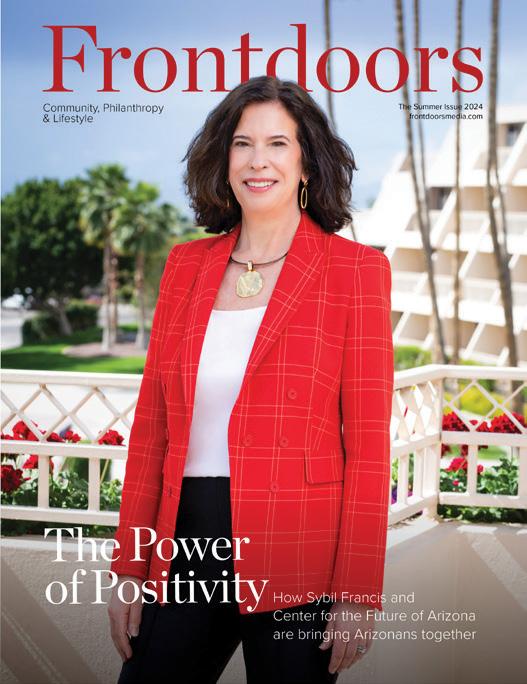


Artlink’s First Friday Art Walk
On the first Friday of each month from 6-10 p.m., Artlink hosts self-guided art walks in Phoenix. Explore over 70 galleries and art-related spaces showcasing a diverse array of artwork while immersing yourself in the vibrant spirit and culture of the city.

Join Green Living and Copenhagen Design for “Prêt-àMode,” a celebration of the future of sustainable fashion and design where 9 designers are competing for the top 3 designs. The event takes place at 15804 N. Scottsdale Road between 5:30-8:30 p.m.. General admission is free. Advance RSVP is recommended, as space is limited.
Escape the heat and explore the Desert Botanical Garden after dark with family and friends. Discover five thematic trails, encounter desert creatures, and enjoy the enchanting nighttime ambiance. Treat yourself to cool drinks, food from local trucks, and s’mores from pop-up bars serving both non-alcoholic and adult beverages. It’s a memorable evening under the stars. 1204 N.Galvin Parkway, Phoenix.
The Embracing Your Journey Expo is the premier holistic, wellness, and metaphysical event in the Valley. This unique gathering offers a platform for vendors and attendees to connect and explore resources aimed at fostering a happier, healthier, and more conscious lifestyle with a diverse array of products and practitioners dedicated to enhancing your mind-body-spirit journey. Held at the New Vision Center for Spiritual Living, 18010 N. Tatum Blvd, Phoenix.
The Everyday is Coffee Day is a virtual race celebrating coffee lovers everywhere and raising awareness around National Suicide Prevention Month. From September 21-30, participants can run or walk at their own pace while supporting a great cause. With 15% of registration fees donated to the American Foundation for Suicide Prevention, this event promotes both fitness and mental health awareness. Sign up for just $18 and receive a medal and bib shipped directly to you.
For information and links about these events and others, visit
Coconino Center for the Arts 40th Anniversary Celebration
Coconino Center for the Arts celebrates 40 years with a weekend of events for all ages. September 6 kicks off the affair with a Curated Culinary Experience with thematic fare and the exhibition "CUMULUS: The Art of Meteorology.” On September 7, experience an evening performance showcasing music, dance, and poetry from regional artists. On September 8, the Emerging + Local Music Festival will feature live music, an art market, food trucks, and a beer garden. Located at Coconino Center for the Arts, 2300 N. Fort Valley Rd., Flagstaff.

Celebrate the arrival of fall at the Cornucopia festival in Flagstaff, featuring a whimsical atmosphere with activities for all ages. Enjoy live entertainment from local performers, explore various vendors, and let the kids have fun in bounce houses and more. Join in the festivities at Thorpe Park Ball Fields.

Celebrate the beauty of Sedona while sipping and savoring local flavors with a weekend of delicious wines from over 22 Arizona wineries. Held at Posse Grounds Park, the event includes live music, food trucks, and artisan vendors from 11 a.m. to 5 p.m. Tickets are $35 in advance or $45 at the door and include eight wine tasting tickets and a commemorative glass. 525 Posse Ground Road, Sedona.
Bat Walk at Kartchner Caverns
Kartchner Caverns invites participants to explore the park and learn about the 13 different bat species that inhabit the area. Using bat detectors, attendees will walk through the beautiful desert night, discovering and listening to these fascinating flying mammals in areas generally off-limits to the public. Registration is required, with a fee of $10 per person. Participants should bring a headlamp or flashlight (black light for children), night vision goggles or similar equipment, comfortable shoes, and plenty of water. The program starts at 6:45 p.m. and ends at 8:15 p.m., with the walk covering just over half a mile. 2980 AZ-90, Benson.

14
For a unique and truly breathtaking evening with family and friends, venture to a secret desert locale to enjoy Lyte — a unique nighttime lantern release like no other. The event takes place from 5-10 p.m. The exact location will be announced to event goers following their ticket purchase.

HungerWalk brings together families, friends, and community members to walk, raise awareness, and raise funds to end hunger. This is a fun event for all ages and features music, entertainment, healthy snacks, games, activities, and more! Kino Sports Complex, 3400 S. Country Club Rd, Tucson.

The markets are inherently volatile. It’s in their nature, whether in response to world events, rising inflation, or a change in interest rates. But sometimes that volatility can work to your advantage.
Reviewing your investment strategy and altering it, if necessary, can help you weather economic uncertainty and keep you on track to achieving your objectives.
Contact us today. We can help keep your goals in focus, no matter what mood the markets are in.
The Ewing-Morales Group of Wells Fargo Advisors

18700 N. Hayden Road Suite 525 Scottsdale , AZ 85255
Direct: (480) 419-2016
mark.morales@wellsfargoadvisors.com https://home.wellsfargoadvisors.com/mark. morales CA Insurance # 0D34255
FLAG STAFF
With large stands of golden aspens and red oaks stealing the show with their quaking leaves.










come Experience the new Astronomy Discovery Center at Lowell Observatory Opening November 16, 2024

Polestar 3
The SUV that drives like a sports car
With up to 315 miles of range and 517 horsepower, Polestar 3 is defining electric performance.* The only way to fully experience that, is a test drive. Visit our Scottsdale space and get behind the wheel of Polestar 3 today.
Also available to view: Polestar 4, an innovative SUV coupé that offers the exhilarating driving experience Polestar is known for. And don’t miss the special offers on Polestar 2, the driver’s EV.